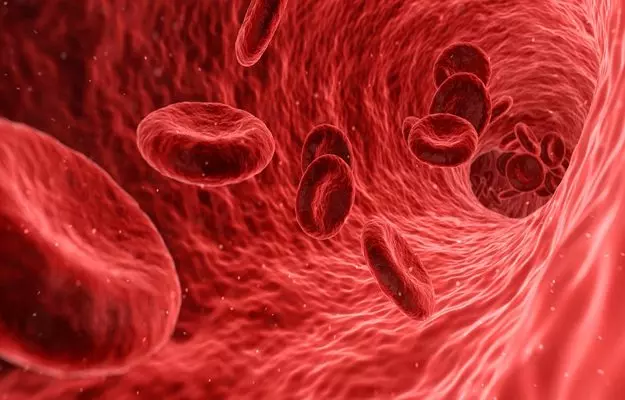Description

Disclaimer: Copyright infringement not intended.
Context
In a study published in Nature, scientists have reported that cells that make cartilage also make haemoglobin.
Details
- The recent discovery of the presence of haemoglobin in cells responsible for cartilage formation, known as chondrocytes, has expanded our understanding of the role of haemoglobin beyond its conventional association with red blood cells.

Key insights from the study
- Unexpected Haemoglobin Presence: The study revealed that chondrocytes, the cells involved in producing cartilage, also manufacture and utilize haemoglobin for their survival, challenging the traditional notion that haemoglobin is exclusively utilized by red blood cells for oxygen transport.
- Discovery of "Haemoglobin Bodies" (Hedy): Researchers identified the formation of spherical structures resembling red blood cells within the chondrocytes, containing haemoglobin. These structures, termed "haemoglobin bodies" or Hedy, were found to be vital for the survival of chondrocytes.
- Essentiality for Chondrocyte Survival: Experiments with genetically modified mice lacking the ability to produce haemoglobin demonstrated that the absence of haemoglobin resulted in significant chondrocyte death. This underscored the crucial role of Hedy in the maintenance of chondrocyte viability.
- Oxygen Transport Function: Studies suggested that Hedy in chondrocytes serves a similar function to that in red blood cells, acting as an oxygen reservoir. When haemoglobin was absent, the chondrocytes exhibited signs of hypoxic stress, indicating the importance of haemoglobin in maintaining appropriate oxygen levels within these cells.
- Wider Implications and Potential Applications: The discovery of functional haemoglobin in cartilage opens up new avenues for research, potentially influencing our understanding of joint diseases and bone deformities. There is also speculation about potential implications for stem cell fate within the growth plate, suggesting a broader impact on skeletal biology.
Haemoglobin
- Definition: Haemoglobin (Hb) is a protein found in red blood cells (RBCs) that is responsible for carrying oxygen from the lungs to the rest of the body's tissues and organs, and for transporting carbon dioxide from the tissues back to the lungs.
- Structure: Haemoglobin is a globular protein composed of four subunits: two alpha chains and two beta chains, each containing a heme group. Each heme group contains an iron ion that can bind to one oxygen molecule.
- Function:
- Oxygen Transport: Haemoglobin binds to oxygen in the lungs and releases it in the body's tissues, facilitating aerobic respiration.
- Carbon Dioxide Transport: Haemoglobin also aids in carrying carbon dioxide, a waste product of metabolism, from the tissues back to the lungs for exhalation.
- Synthesis and Regulation:
- Erythropoiesis: Haemoglobin synthesis occurs during erythropoiesis, the process of RBC formation in the bone marrow, regulated by the hormone erythropoietin.
- Regulatory Mechanisms: The synthesis and regulation of haemoglobin are influenced by various factors, including iron availability, oxygen levels, and hormonal signals such as erythropoietin.
- Variants and Abnormalities:
- Sickle Cell Disease: A genetic disorder caused by a mutation in the HBB gene, resulting in the production of abnormal hemoglobin (HbS), leading to the characteristic sickle-shaped RBCs and various health complications.
- Thalassemia: A group of genetic disorders characterized by reduced or absent synthesis of one of the globin chains, resulting in abnormal haemoglobin production and, consequently, anemia.
- Measurement:
- Hemoglobin Levels: The amount of haemoglobin in the blood is often measured to assess the oxygen-carrying capacity of the blood, with normal ranges varying with age and sex.
- Clinical Significance: Abnormal haemoglobin levels can indicate various conditions, such as anemia, polycythemia, or other underlying health issues.
- Interactions and Significance:
- Oxygen Dissociation Curve: The relationship between haemoglobin saturation and partial pressure of oxygen, crucial for understanding how haemoglobin releases and picks up oxygen in different tissues.
- Bohr Effect: Haemoglobin's ability to bind or release oxygen is affected by factors such as pH, carbon dioxide levels, and temperature, influencing its function in different physiological conditions.

Conclusion
This groundbreaking study not only challenges our understanding of the role of haemoglobin but also emphasizes the interconnectedness between different biological processes and disciplines, highlighting the need for further research into the implications of haemoglobin presence in non-traditional cell types.
|
PRACTICE QUESTION
Q. Discuss the multifaceted roles of haemoglobin in the human body, highlighting its functions beyond oxygen transport. (250 Words)
|











